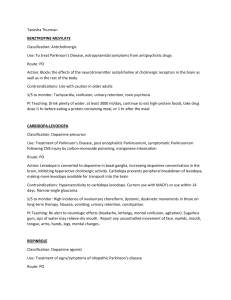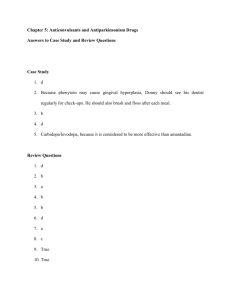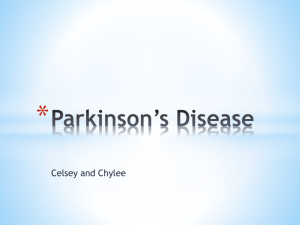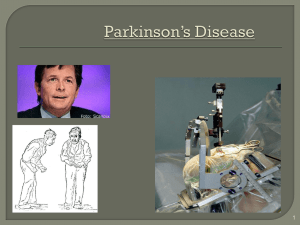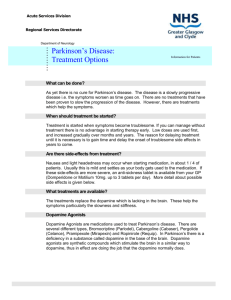Parkinson's & Epilepsy Case Studies: Symptoms & Treatment
advertisement
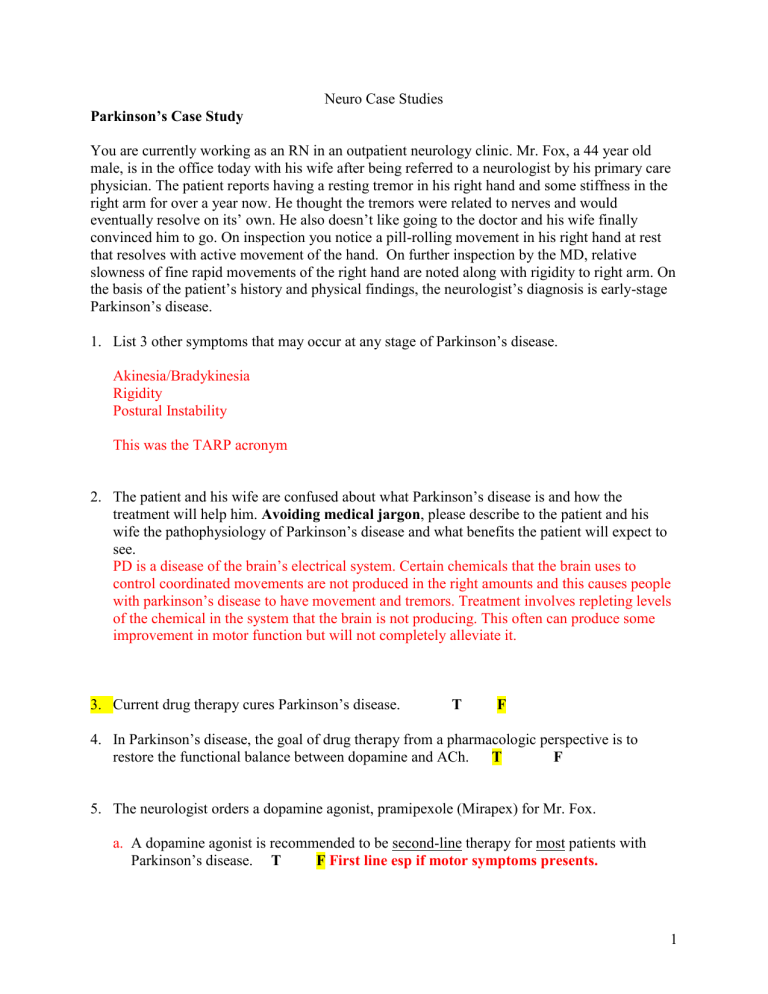
Neuro Case Studies Parkinson’s Case Study You are currently working as an RN in an outpatient neurology clinic. Mr. Fox, a 44 year old male, is in the office today with his wife after being referred to a neurologist by his primary care physician. The patient reports having a resting tremor in his right hand and some stiffness in the right arm for over a year now. He thought the tremors were related to nerves and would eventually resolve on its’ own. He also doesn’t like going to the doctor and his wife finally convinced him to go. On inspection you notice a pill-rolling movement in his right hand at rest that resolves with active movement of the hand. On further inspection by the MD, relative slowness of fine rapid movements of the right hand are noted along with rigidity to right arm. On the basis of the patient’s history and physical findings, the neurologist’s diagnosis is early-stage Parkinson’s disease. 1. List 3 other symptoms that may occur at any stage of Parkinson’s disease. Akinesia/Bradykinesia Rigidity Postural Instability This was the TARP acronym 2. The patient and his wife are confused about what Parkinson’s disease is and how the treatment will help him. Avoiding medical jargon, please describe to the patient and his wife the pathophysiology of Parkinson’s disease and what benefits the patient will expect to see. PD is a disease of the brain’s electrical system. Certain chemicals that the brain uses to control coordinated movements are not produced in the right amounts and this causes people with parkinson’s disease to have movement and tremors. Treatment involves repleting levels of the chemical in the system that the brain is not producing. This often can produce some improvement in motor function but will not completely alleviate it. 3. Current drug therapy cures Parkinson’s disease. T F 4. In Parkinson’s disease, the goal of drug therapy from a pharmacologic perspective is to restore the functional balance between dopamine and ACh. T F 5. The neurologist orders a dopamine agonist, pramipexole (Mirapex) for Mr. Fox. a. A dopamine agonist is recommended to be second-line therapy for most patients with Parkinson’s disease. T F First line esp if motor symptoms presents. 1 b. Dopamine agonists work by activating dopamine receptors in the striatum. T F c. What are two advantages of using a dopamine agonist over Levodopa? Transdermal dosing Less dyskinesia side effects Do not require enzymatic conversion to become active Not converted to metabolites Do not compete with dietary protein for uptake d. What are two disadvantages of using a dopamine agonist over Levodopa? Less effective than Levodopa More side effects Mr. Fox’s symptoms of Parkinson’s are well-controlled with pramipexole (Mirapex) for a few years. However, on a follow-up visit he reports his symptoms are no longer controlled with pramipexole and he has tremors and stiffness in all 4 extremities. The neurologist considers whether to add Levodopa or Sinemet (Levodopa + Carbidopa) to Mr. Fox’s treatment plan. 1. Dopamine is decreased in Parkinson’s disease. Therefore, should dopamine administration also be considered as part of his treatment plan? Why or Why not? Dopamine agonists yes but plain dopamine no because it does not cross the blood brain barrier and has a very short half life 2. Patients who are receiving Levodopa may need to be placed on a “drug holiday.” What is a drug holiday? And when might this be necessary? Drug Holiday is done to reset the clock so to speak. After longer times on therapy people become resistant to the effects fo these medications so by stopping the drug they can reset and will respond better to therapy. 3. Acute loss of effect may occur in patients on Levodopa and can present in two patterns: gradual loss and abrupt loss. What is the difference between these two patterns? Give one intervention for how to minimize each pattern. Abrupt loss can happen at any time during therapy and last from minutes to hours. It is when drug effects are lost for a period of time. Avoiding high protein meals might help prevent this from happening. Gradual loss occurs at end of dosing interval where the effects have simply worn off for this you can add another drug or give doses closer together. 4. How does Carbidopa enhance the benefits and reduce the side effects of Levodopa? Carbidopa increases amount of levodopa available for use Reduces amount of dopamine produced in periphery therefore reducing dopamine induced side effects 2 Epilepsy Case Study Mrs. Orange, a 22 year old woman, is referred to the epilepsy center where you work because of intractable seizures. She had had three brief febrile seizures at the age of 2, had taken Phenobarbital until age 5, and then had no further problems until age 14. She then had a convulsion and was noted to have staring spells. Phenytoin prevented further convulsions, but her acne worsened and she complained of facial hair. She continued to have 2 to 4 staring spells per month; they began with a “rising feeling” in the pit of her stomach, followed by a sudden sense that everything had happened before, then amnesia for the rest of the seizure. At this point, her family described a blank stare, with some lip smacking and aimless pulling at her clothes, for approximately 4 minutes. Eventually, a combination of carbamazepine and valproic acid reduced the seizure frequency to 2 per month, but maximally tolerated dosages of each drug failed to render her seizure-free. She is engaged and would like to have children. 1. What type of seizures is she having? Mixed seizures or Absence seizures 2. In a generalized seizure, focal seizure activity spreads widely throughout both cerebral hemispheres. T F 3. Describe the pathophysiology of epilepsy. In general, how do antiepileptic drugs (AEDs) work to correct this? Overstimulation of brain neurons AED’s work on the neurons action potential to decrease firing of the neurons. 4. AEDs act through 3 basic mechanisms. a. List these mechanisms and describe how AEDs work through these mechanisms to suppress seizure activity. By suppressing sodium, calcium influx. Promoting potassium efflux, binding to NMDA and AMPA receptors (antagonizing glutamate) Potentiation of GABA by augmenting the inhibitory effects of GABA. b. What mechanism(s) does Mrs. Orange’s recent antiepileptic drugs (carbamazepine and valproic acid) act through? Suppressing sodium channels c. For Mrs. Orange, what is the goal antiepileptic therapy? Quality of life by decreasing seizure activity. 5. A seizure type diagnosis is not necessary in order to prescribe AED treatment. T F 6. Give two examples of how you can promote compliance in a patient with epilepsy? Drug evaluation- trial period, dose adjustments Patient Teaching- side effects, dietary requirements 3 7. What would be one benefit to monitoring plasma drug levels in Mrs. Orange? This would not be as helpful in her due to absence of seizures but could be used if having lots of side effects or seizures 8. If the plan was to stop the use of AEDs in Mrs. Orange for pregnancy, it would be safe to stop her AEDs immediately. T F She should be weaned slowly off these drugs over 4-8 weeks. 4
